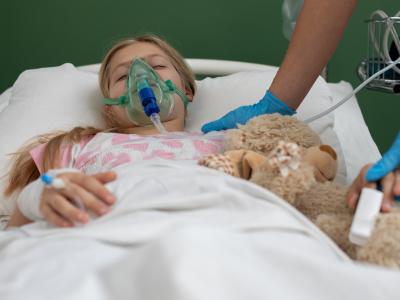Tennessee study links infant antibiotic exposure to childhood asthma
Researchers from Vanderbilt University Medical Center have found a dose-dependent association between infant antibiotic exposure and subsequent development of childhood asthma, according to a new study in Clinical Infectious Diseases.
In a population-based cohort study of 152,622 singleton, term birth, and non–low-birth-weight children born from 1995 through 2003 and enrolled in Tennessee's Medicaid program, 79% had at least one antibiotic prescription filled during their first year of life. Among the children who had at least one antibiotic fill, the median number of fills was four. The prevalence of asthma by age 6 was 14%.
Using multivariable logistic regression models, the researchers found that, compared with children who did not have an antibiotic fill during infancy, children who had at least one fill had nearly double the odds of developing asthma by age 6 (adjusted odds ratio [aOR], 1.88; 95% confidence interval [CI], 1.80 to 1.95). With each additional fill, the odds of having asthma by age 6 increased by 20% (aOR, 1.20; 95% CI, 1.19 to 1.20), and the dose-dependent relationship persisted after additionally controlling for timing and type of antibiotics.
While the study also showed that infants who had broad-spectrum-only antibiotic fills had increased odds of developing asthma compared with those who received only narrow-spectrum antibiotics (aOR, 1.10; 95% CI, 1.05 to 1.19), no association was observed between the timing, formulation, anaerobic coverage, and class of antibiotics and childhood asthma.
The authors of the study note that they can neither confirm nor refute the causative role of antibiotics in the development of childhood asthma, and that they could not include in their analysis several factors known to be associated with asthma risk, including breastfeeding, exposure to mold or pets, daycare attendance, and other environmental exposures.
They conclude, "In light of the mounting evidence supporting the detrimental effect of infant antibiotic use on childhood asthma, patients and healthcare providers should critically weigh the risks and benefits of antibiotic use in infants before administration, considering possible alternative treatment strategies when available, and the research community should focus on how the adverse effects of antibiotics could be prevented when their use is required."
May 31 Clin Infect Dis abstract
FDA approves combination drug for healthcare-acquired pneumonia
The US Food and Drug Administration (FDA) today announced the approval of Zerbaxa (ceftolozane and tazobactam) for the treatment of hospital-acquired and ventilator-associated bacterial pneumonia (HABP/VABP).
The approval of the supplemental New Drug Application (NDA) for Zerbaxa, which combines an anti-pseudomonal cephalosporin (ceftolozane) with an extended-spectrum beta-lactamase inhibitor (tazobactam), was based on the results of the phase 3 ASPECT-NP trial. The study found that Zerbaxa was safe and non-inferior to meropenem in 726 adult patients with HABP/VABP, showing similar 28-day mortality rates and cure rates in the intention-to-treat population. The approval was granted to Merck & Co.
Zerbaxa was already approved in the United States for treating complicated urinary tract infections and complicated intra-abdominal infections. The FDA agreed to a priority review of the supplemental NDA in April, citing an unmet need for new treatment options for healthcare-acquired pneumonia.
"Hospital-acquired and ventilator-associated bacterial pneumonia are serious infections that can result in death in some patients," FDA Principal Deputy Commissioner Amy Abernathy, MD, PhD, said in an FDA press release. "New therapies to treat these infections are important to meet patient needs because of increasing antimicrobial resistance."
According to the Centers for Disease Control and Prevention, HABP and VABP are the second most common type of hospital-acquired infection in the United States.
Jun 3 FDA press release
Groups urge passage of NY bill to restrict antibiotic use in farm animals
A coalition of environmental, health, and consumer groups today called on New York's governor and state legislative leaders to support passage of a bill that would ban the use of antibiotics for disease prevention in food-producing animals.
In a letter to Governor Andrew Cuomo and legislative leaders, the groups cite overuse and misuse of antibiotics in food-animal production as a significant contributor to antibiotic resistance and the emergence of multidrug-resistant organisms that can infect people via food, water, airborne dust, and worker exposure. They argue that, with the lack of action from the federal government, states like New York need to address the issue by limiting antibiotic use in food animals to only when it is medically necessary.
The legislation, introduced by Senator Brian Kavanagh and Assemblywoman Jamie Romeo, would restrict veterinarians to using antibiotics only to treat animals that are sick, in relation to certain medical procedures, or to control outbreaks of disease from contagious animals. Similar legislation has been passed in Maryland and California.
"The overuse and misuse of antibiotics in agriculture is a big contributing factor in a growing public health crisis that needs to be addressed if we are to avoid widespread catastrophic illnesses that people routinely experienced before the development of effective antibiotics," Kavanagh said in press release from New York Public Interest Research Group (NYPIRG), one of the organizations that signed the letter. "We have an opportunity take action now."
Jun 3 NYPIRG press release












